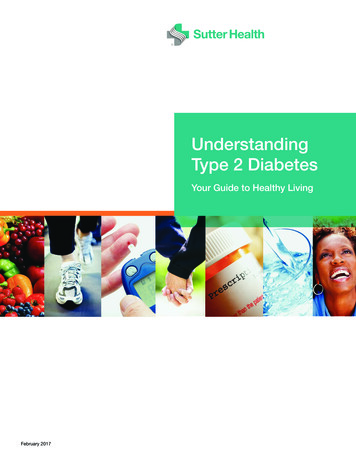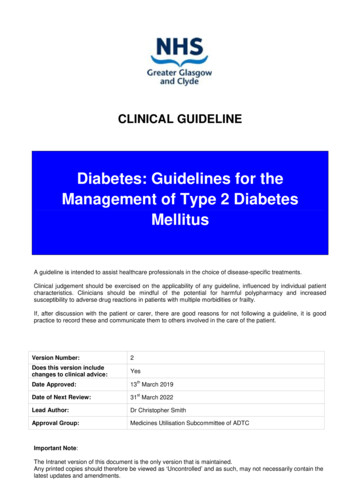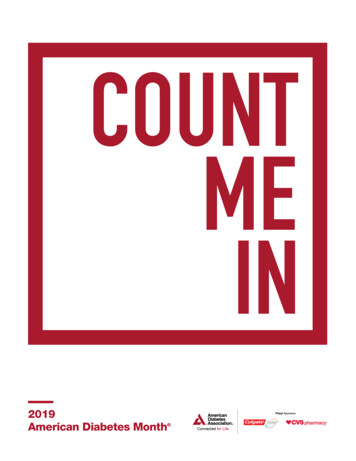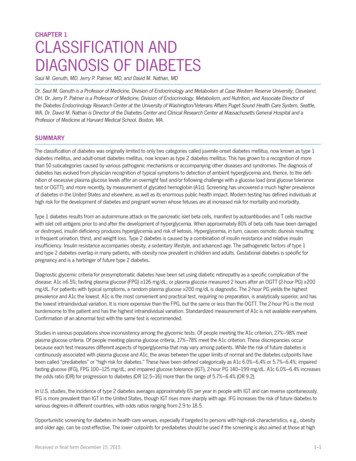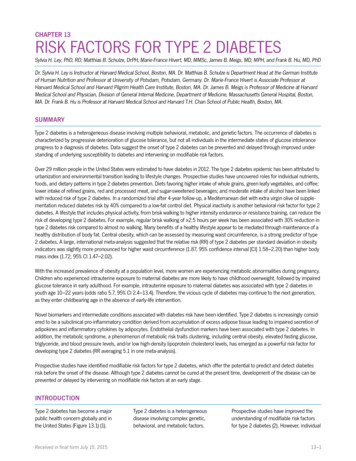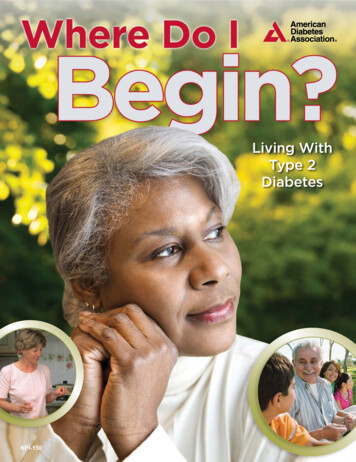
Transcription
Living WithType 2DiabetesNPI-150
Join TodayDiabetes is a journey. There’s a lot to learn, but you don’t have to do it alone.The American Diabetes Association is ready to help you every step of the way.This booklet will help you get started but to get more information, join theLiving With Type 2 Diabetes program.Living With Type 2 Diabetes is a free, year-long program that offers informationand support as you learn to live with diabetes. Enrollees receive: Delicious and healthy recipesfor you and your family Tools and information to helpyou take care of your diabetes Opportunities for support onlineand in your communityYour first month’s packet will be onFood and Nutrition. Future packetsinclude topics on Stress andEmotions, Physical Activity,and Preventing Complications.Join the Living With Type 2 Diabetes program today! Fill out the card on the back of this booklet and mail it back to us(no postage needed), or Call 1-800-DIABETES (1-800-342-2383), or Visit diabetes.org/livingSnap a photo of this QR code* to go to the Living With Type 2 Diabetes programenrollment page!*Download a free code reader app for your smartphone at your phone’s marketplaceThe American Diabetes Association is leadingthe movement to Stop Diabetes . By joining theLiving With Type 2 Diabetes program, you canhelp Stop Diabetes and change the future of thisdisease. To learn more about the movement, visitstopdiabetes.com or call 1-800-DIABETES.
Table of ContentsLiving With Type 2 Diabetes . 4What Is Type 2 Diabetes? . 5Taking Care of Your Diabetes . 6Choosing What, How Much, and When to Eat . 7Create Your Plate . 8Getting Active . 10Checking Blood Glucose . 12Medicines . 13How Do You Feel? . 14Getting Support . 15Get to Know your American Diabetes Association . back coverWhere Do I Begin?Enroll Today!3
Start Here: Living With Type 2 DiabetesFirst, take a deep breath.You have type 2 diabetes. And yes, it’s a big deal. But you know what? It’s also something youcan deal with. And the American Diabetes Association is here to help.When people first find out that they have diabetes, they sometimes find it really scary, orsad, or even hard to believe. After all, you probably don’t feel sick, or any different than youfelt before you were told you have diabetes. And yet it is very important to take this diseaseseriously.Some people who learn they have diabetes worry that it means their life is over, or that theywon’t be able to do everything they used to do. Neither of those things is true. What is true isthat you may need to change some things about your daily routine. It’s not your fault that yougot diabetes, but it is your job to take care of yourself.Luckily, there’s a lot that you can do to keep yourself healthy. This booklet will give you thefirst steps for taking control of your diabetes.4www.diabetes.org1-800-DIABETES
Getting With DiabetesWhat Is Type 2 Diabetes?When you eat, your food is broken down into a sugar called glucose. Glucose gives yourbody the energy it needs to work. But to use glucose as energy, your body needs insulin.When you have type 2 diabetes, your body does not make enough insulin or use it well.Since your body’s cells can’t use the glucose from your food as energy, the glucose stays inyour blood, where it can cause serious problems.There is no cure for diabetes, but it can be managed. Balancing the food you eat withexercise and medicine (if prescribed) can keep your blood glucose in a healthy range. Manypeople with diabetes live long and healthful lives.TIPYou can ask your doctorfor a referral to a diabetes educationprogram recognized by the AmericanDiabetes Association. Find a programnear you at diabetes.org/ERP or call1-800-DIABETES.Where Do I Begin?Enroll Today!5
Taking Care of Your DiabetesYour diabetes care team will help you, but day-to-day diabetes care is up to you. That careincludes: Choosing what, how much, and when to eat Getting physically active Checking your blood glucose (if your doctor prescribes it) Taking medicine (if your doctor prescribes it) Going to your appointments Learning all you can about diabetesEnroll today! Complete the postcard in this booklet,call 1-800-DIABETES (342-2383)or visit diabetes.org/living.Who’s on My Diabetes Care Team?Your diabetes care team may include your doctor, nurse,dietitian, pharmacist, diabetes educator and any otherhealth care provider working to help you care for yourdiabetes. Other specialists, such as an endocrinologist,ophthalmologist or podiatrist, may become involvedas needed, too. And remember, you and your familyand friends are the most important members of yourdiabetes care team.6www.diabetes.org1-800-DIABETES
Choosing What, How Much, and When to EatIn the past, diets for people with diabeteswere very restrictive. Things are different now.There isn’t a one-size-fits-all diabetes diet.While you may need to make some changes inwhat and how much you eat, you have flexibilityin deciding what’s on the menu. With a littleplanning, you can still include your favorite foods.Create Your PlateTIPWhat does “healthy eating”really mean? Eating a variety of foods, includingvegetables, whole grains, fruits, nonfat dairy foods, healthy fats, and leanmeats or meat substitutes Trying not to eat too much food Trying not to eat too much of one typeof foodTrying to figure out how you’re supposedto eat now that you have diabetes? A good Spacing your meals evenly throughoutplace to begin is the “Plate Method.” Youthe daydon’t need any special tools and don’t need Not skipping mealsto do any counting. You just need to focuson filling your plate with more non-starchyvegetables and less starchy foods andmeats. It’s simple and it works. Find out how to use the Plate Method on the next page!Weight LossIf you are overweight or obese, your doctor or diabetes care team may suggest you try tolose some weight.Losing weight can improve your blood glucose, blood pressure and cholesterol. You don’t haveto lose a lot of weight to start seeing results. Just losing 10–15 pounds can make a difference.The key to losing weight in a healthy way is to do so gradually. Avoid crash diets, and above all,follow the guidance of your doctor or dietitian to create a diet that will work for you.There are many types of weight loss plans to choose from. Even using the Plate Method formeal planning can help with weight loss. If you’re having trouble losing weight, talk with yourdoctor or a registered dietitian.Future mailings of the American Diabetes Association Living With Type 2 Diabetes programinclude more information about weight loss.Where Do I Begin?Enroll Today!7
CreateYourPlate!12345Imagine drawing a line down themiddle of your dinner plate. Thenon one side, cut it again so you willhave 3 sections on your plate likethe picture on your right.Fill the largest section with nonstarchy vegetables like salad,green beans, broccoli, cauliflower,cabbage, carrots, and tomatoes.Now in one of the smaller sections,put starchy foods such as noodles,rice, corn, or potatoes.The other small section is for meat,fish, chicken, eggs, or tofu.Add an 8 oz glass of milk and onesmall piece of fruit or 1/2 cup of fruitsalad and you’ve got a great meal.(If you don’t drink milk, you can addan extra piece of fruit, light yogurt,or a small roll.)Grains and Starchy Vegetables whole grain breads, such as whole wheat or rye whole grain, high-fiber cereal cooked cereal such as oatmeal, grits, hominy,or cream of wheat rice, pasta, barley, tortillas cooked beans and peas, such aspinto beans or black-eyed peas potatoes, green peas, corn,lima beans, sweet potatoes,winter squash low-fat crackers andsnack chips, pretzels,and fat-freepopcorn*Once you havechanged how muchyou are eating, youcan work on makinghealthier choices ofeach type of food.Protein chicken or turkey(without the skin) fish such as tuna,salmon, cod, or catfish other seafood such asshrimp, clams, oysters,crab, or mussels lean cuts of beef and porksuch as sirloin or pork loin tofu, eggs, low-fat cheese81-800-DIABETES
Milk skim, 1/2%, or 1% milk low-fat or fat-free yogurt plain soy milkFruit fresh, frozen, or canned injuice or light syrup peach, pineapple, banana,apple, pear, mango, grapes,berries, melon, papaya,apricot, orange,grapefruitNon-StarchyVegetables fresh, frozen,or canned spinach, carrots,lettuce, greens,cabbage, bokchoy, greenbeans, broccoli,cauliflower,tomatoes,vegetable juice,salsa, onion,cucumber, beets,okra, mushrooms,peppers, turnip?www.diabetes.orgHow Deep?For the plate method, yourfood can be piled about thethickness of a deck of cardsor the palm of your hand.9
“I’ve met others who are also living withdiabetes and it’s a great way for me to getexercise. I love being a Red Rider.”Learn more at diabetes.org/redriderGetting ActiveBeing active is another part of livinghealthy and managing diabetes. Any typeof physical activity you do helps lower yourblood glucose.Other benefits of physical activityinclude: Having more energy Relieving stress Keeping your joints flexible Lowering your risk for heart diseaseand stroke Feeling greatTalk to your doctor if you have questionsabout which activities are right for you.Examples of different types of physicalactivity include: Aerobic activity (walking, biking,swimming) Being active throughout the day(taking the stairs instead of anelevator) Strength training (lifting weights orusing resistance bands) Flexibility exercises (stretching andyoga)Aerobic ActivityAerobic activity makes your heart andbones strong, relieves stress, helps yourinsulin work better and improves bloodflow. For most people, it’s best to aim fora total of 30 minutes of exercise a day,at least 5 days a week. If you are tryingto lose weight, you may want to exercisemore than 30 minutes a day.10www.diabetes.org1-800-DIABETES
Here are some examples of aerobic activity: Take a brisk walk Go dancing Take an aerobics class Swim or do water aerobicsEnroll Today!Complete the postcard in this booklet,call 1-800-DIABETES (342-2383) orvisit diabetes.org/living. Go for a bike ride or use a stationary bike indoorsIf you haven’t been very active recently, you can start out with 5 or 10 minutes a day andwork up to more time each week. You can also split up your activity for the day: For example,take a quick 10-minute walk before or after each meal instead of 30 minutes all at once.Being Active Throughout the DayIn addition to aerobic activity or other planned exercise, there are many ways to be moreactive during your day. This can help you burn calories and lower your blood glucose. Hereare some examples: Walk instead of drive Get off the bus a stop early and walk the rest of the way Work in the garden, rake leaves or wash the car Play actively with kids Walk around while talking on the phone Park at the far end of the lot and walk“I don’t feel so alone when I’m walking with fellow Red Striders.There’s a feeling of unity when we walk together.”Learn more atdiabetes.org/redstriderWhere Do I Begin?Enroll Today!11
Checking Blood GlucoseYour doctor may want you to start checking your blood glucose at home. If this is the case,you will need to get a small machine called a blood glucose meter. Meters are available indrug stores. Ask your doctor or diabetes educator to help you select a meter that works bestfor you and is covered by your insurance.How does a meter work?Meters work by testing a small drop of your blood for glucose. Most people prick their fingertipto get the blood drop, but you can ask your diabetes educator or doctor about other methods.Why is it important?Before you had diabetes, no matter what you ate or how active you were, your blood glucoseautomatically stayed within a normal range. With diabetes, this is no longer true.Checking your blood glucose is one way you can know how food, activity and medicine affectyour blood glucose. It can help you make sure your blood glucose isn’t going too high or too low.Write the date, time and blood glucose number in a logbook so you can share it with yourdiabetes care team. Together with the team, you can use your logbook to make decisionsabout food, physical activity and medicine.Talk with your doctor or your diabetes care team about how often and when you shouldcheck your blood glucose. Before a meal or two hours after a meal are common times tocheck blood glucose. Also talk with your doctor about what your target numbers should be.12www.diabetes.org1-800-DIABETES
MedicinesYour doctor may prescribe medicine to help get and keep your blood glucose in your targetrange. There are different types of diabetes medicines that work in different ways to lowerblood glucose. Your doctor may prescribe more than one to help you get to your target range.Some people with type 2 diabetes take both pills and insulin or insulin by itself.If you are starting new medicines, ask your doctor, pharmacist or diabetes educator thefollowing questions: How many pills do I take? How often should I take them, and when? Should I take my medicine on an empty stomach or with food? What if I forget to take my medicine and remember later? What side effects could I have? What should I do if I have side effects? Will my diabetes medicine cause a problem with any of my other medicines?If you think you are having side effects from your medicine, or have questions, call your doctoror pharmacist. Don’t stop taking it unless the doctor tells you to. Remember, your medicine willwork best if you also make healthy changes to how you eat and if you are active.Where Do I Begin?Enroll Today!13
How Do You Feel?Different people have different feelings about getting type 2 diabetes. Some of the usualreactions are: A sense of loss Fear Stress Anger Shock Guilt Disbelief and not wanting to think about itThe thing to remember is that all of thesefeelings are completely normal. Finding outthat you have diabetes is a big deal. Andeven if you’re doing great with it now, theremay be moments where you feel bad aboutwhat has happened to you.TIPAsk your diabetes care team tohelp if your feelings are overwhelming youor affecting the way you take care of yourself.Your health care provider can suggest ways tohelp you cope with difficult feelings.It’s a great idea to talk to family, friends,or your doctor about how you’re feeling.Sometimes just putting your thoughts intowords makes dealing with them easier.Other people may be able to help you see the positive side of things, or figure out ways toreduce the stress.14www.diabetes.org1-800-DIABETES
Getting SupportYour family and friends can be a great source of support because they care about you. Butthey can’t help you with diabetes unless they understand it. You can help them by tellingthem what you need from them. Try some of these ideas: Ask them to learn about how diabetes affects your body and emotions. Invite them to attend your appointments or diabetes classes. Include them in your new healthy lifestyle. Share this booklet with them. Ask for help when you need it.You want the people around you to know how to help, but it’s also okay to tell them if youdon’t want their help.Where Do I Begin?Enroll Today!15
Get to Knowyour American Diabetes AssociationOur mission is to prevent and cure diabetes and to improve the lives of all peopleaffected by diabetes.In Your CommunityThrough programs like Living With Type2 Diabetes, Live Empowered and Por tuFamilia, we offer information, educationand resources to people living withdiabetes.Through events such as EXPO, Step Out:Walk to Stop Diabetes and Tour de Cure,we raise funds and awareness aboutdiabetes.There are 3 easy ways to join the FREELiving With Type 2 Diabetes program to getmore information, new recipes and connectwith others living with diabetes. You can Call 1-800-DIABETES Go to diabetes.org/living, or Return the postcard found in this bookletFind us in your community at diabetes.org/community or call 1-888-DIABETES (342-2383).The Latest Information on DiabetesWe offer free information and resources online at diabetes.org and through our Center forInformation and Community Support. Trained representatives are available to help you findanswers to your questions about diabetes. Call us at 1-800-DIABETES (342-2383), chatwith us at diabetes.org/chat, or email us at AskADA@diabetes.org.Legal AdvocacyThrough the Americans with Disabilities Act, people with diabetes have rights that protectthem against discrimination because of diabetes. If you have questions about discrimination,visit diabetes.org/discrimination or call 1-800-DIABETES (342-2383).ResearchWe invest millions of dollars in research aimed at preventing, treating and curing diabetes.Learn more about current research in diabetes at diabetes.org/research.We are leading the movement to Stop Diabetes.Join the MillionsSM at stopdiabetes.com.Funding for the Living With Type 2 Diabetes programhas been made possible by a generous grant from:Additional funding has been provided by:
Living With Type 2 Diabetes is a free, year-long program that offers information and support as you learn to live with diabetes. Enrollees receive: . Snap a photo of this QR code* to go to the Living With Type 2 Diabetes program enrollment page! *Download a free code reader app for your


